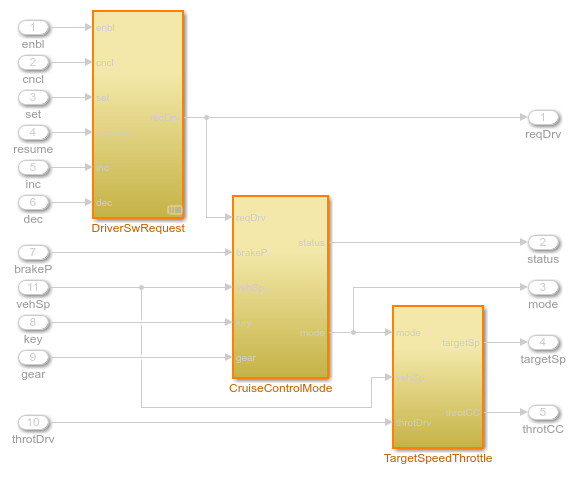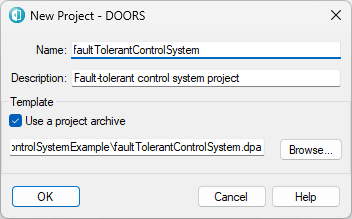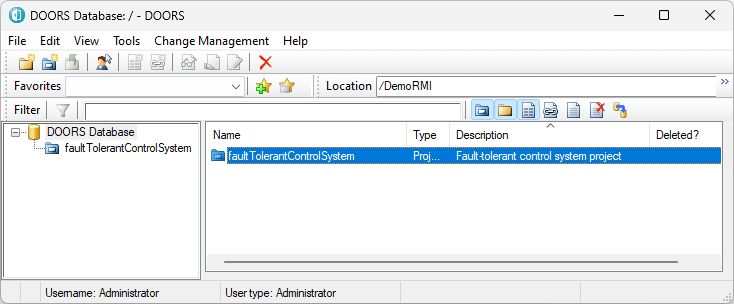rmi
Requirements Toolbox のプログラムによる操作
構文
説明
リンク情報の取得
linkedDest = rmi("get",modelOrBlock)modelOrBlock で指定されたモデルまたはモデル要素からの外向きリンクのリンク先を返します。
numLinks = rmi("count",modelOrBlock)modelOrBlock で指定された最上位モデルまたはモデル要素からの外向きリンクの数を返します。
descriptions = rmi("descriptions",modelOrBlock)modelOrBlock で指定されたモデルまたはモデル要素のリンク先の説明を返します。
codeComments = rmi("codeComment",modelOrBlock)modelOrBlock で指定されたモデルまたはモデル要素からリンクされた要件に対応するコード コメントを返します。これらのコメントは、モデルからコードを生成するときに Requirements Toolbox™ によって生成コードに挿入されます。詳細については、モデルから生成されたコードまでの要件のトレースを参照してください。
linkedDest = rmi("codeReqs",modelOrBlock)modelOrBlock で指定されたモデルまたはモデル要素からの要件へのリンクについて、Requirements Toolbox が生成コードに含めるリンク先を返します。モデル要素が Simulink® ライブラリのブロックの参照インスタンスである場合、ライブラリ ブロックからと参照ブロックからの両方のリンクがリンク先に含まれます。モデル要素が Simulink ライブラリのブロックの参照インスタンスでない場合、この関数の出力は rmi("get", の出力と同じです。ライブラリ ブロックの参照インスタンスの詳細については、リンク付きブロック (Simulink)を参照してください。modelOrBlock)
リンクの削除
rmi("clearAll", は、最上位モデルまたはモデル要素からの外向きリンクを削除するよう求めるダイアログ ボックスを開きます。modelOrBlock)
rmi(___,"noPrompt") は、ダイアログ ボックスを開かずに外向きリンクを削除します。前の 2 つの構文のいずれかを使用し、その後に引数 noPrompt を続けます。
モデルの操作
[ は、blockHandles,modelIndices,isSf,objSIDs] = rmi("getObjectsInModel",model)model で指定されたモデル内の各モデル要素について、ブロック ハンドル blockHandles、モデルの階層構造のインデックス parentIndices、モデル要素が Stateflow® チャートに属するかどうかを示すインジケーター isSf、およびモデル要素の SID objSIDs を返します。
[ は、modelOrBlockName,modelOrBlockType] = rmi("getObjLabel",modelOrBlock)modelOrBlock で指定されたモデルまたはモデル要素の名前とタイプを返します。
guidChar = rmi("guidGet",modelOrBlock)modelOrBlock で指定されたモデルまたはモデル要素のグローバル一意識別子を返します。modelOrBlock にグローバル一意識別子がない場合、この関数で作成されます。グローバル一意識別子は REQ ファイルでのみ使用されます。
トレーサビリティのレポート
rmi("report", は、artifactToReport)artifactToReport で指定されたアーティファクトについて HTML 形式のトレーサビリティ レポートを生成します。トレーサビリティ レポートの詳細については、要件トレーサビリティ レポートの作成とカスタマイズを参照してください。
rmi projectReport は、現在のプロジェクト内のファイルについて HTML 形式のトレーサビリティ レポートを生成します。このレポートの最上位ページには、外向きリンクをもつ各プロジェクト ファイルのレポートへのリンクが含まれています。詳細については、プロジェクトの要件トレーサビリティ レポートの作成を参照してください。
サードパーティ製ツールとの統合
rmi register は、登録関数 myCustomDocInterfacemyCustomDocInterface で指定されたカスタム ドキュメント インターフェイスを登録します。これにより、Requirements Toolbox で組み込みサポートが提供されていないサードパーティ製アプリケーションの要件への直接リンクを作成できます。詳細については、Define Custom Document Interface for Direct Linking to Requirementsを参照してください。
rmi unregister は、登録関数 myCustomDocInterfacemyCustomDocInterface で指定されたカスタム ドキュメント インターフェイスの登録を解除します。詳細については、Define Custom Document Interface for Direct Linking to Requirementsを参照してください。
rmi httpLink は、HTTP プロトコルを使用するブラウザー ベースのサードパーティ製要件ツールのバックリンクから MATLAB® または Simulink のリンク項目へのナビゲートに使用できる内部 HTTP サーバーをアクティブにします。HTTPS サーバーのバックリンク ナビゲーションは既定で有効になっています。
メモ
あるいは、rmipref 関数を使用して UnsecureHttpRequests 基本設定を true に設定することで内部 HTTP サーバーをアクティブにすることもできます。UnsecureHttpRequests 基本設定が true の場合、MATLAB の起動時に内部 HTTP サーバーがアクティブになります。
connectorStatus = rmi("httpLink","status")0 の場合、サーバーがアクティブになっていません。
rmi setup は、Microsoft® Office および IBM® DOORS® との相互作用のためにコマンド ラインで Requirements Toolbox を構成するためのプロンプトを開きます。詳細については、Microsoft Office および IBM DOORS との相互作用のための Requirements Toolbox の構成を参照してください。
rmi setup doors は、IBM DOORS との相互作用のためにコマンド ラインで Requirements Toolbox を構成するためのプロンプトを開きます。詳細については、Microsoft Office および IBM DOORS との相互作用のための Requirements Toolbox の構成を参照してください。
rmi("doorsSync", は、model)model で指定された Simulink モデルの IBM DOORS 同期設定ダイアログ ボックスを開きます。IBM DOORS の同期の詳細については、Synchronize Requirements Traceability in IBM DOORS by Using Surrogate Modulesを参照してください。
currentSettings = rmi("doorsSync",model,"settings")model で指定された Simulink モデルの現在の IBM DOORS 同期設定を返します。設定を変更するには、IBM DOORS 同期設定ダイアログ ボックスを使用して変更を加え、[設定の保存] をクリックします。
ヒント
既定の設定を返すには、model を [] として指定します。
rmi("doorsSync", は、model,syncSettings)syncSettings で指定された同期設定を使用して、model で指定された Simulink モデルから IBM DOORS サロゲート モジュールを作成します。IBM DOORS サロゲート モジュールが既に存在する場合、この関数はモデルとモジュールを再同期してサロゲート モジュールを更新します。IBM DOORS の同期の詳細については、Synchronize Requirements Traceability in IBM DOORS by Using Surrogate Modulesを参照してください。
numScreenshots = rmi("surrogateUpdateScreenshots",model)
currentTemplate = rmi("getDoorsLabelTemplate")
tf = rmi("setDoorsLabelTemplate",customTemplate)customTemplate で指定された形式に設定し、成功ステータスを返します。既定のラベル テンプレートには、DOORS 要件リンク ターゲットのセクション番号およびオブジェクト見出しが含まれています。
ヒント
リンク ラベル テンプレートを既定のテンプレートに戻すには、MATLAB コマンド プロンプトで次のコマンドを入力します。
tf = rmi("setDoorsLabelTemplate","")
label = rmi("doorsLabel",moduleID,doorsReqID)moduleID で指定されたモジュール内の doorsReqID で指定された IBM DOORS 要件へのリンクを作成するときに Requirements Toolbox が使用するリンク ラベルを返します。
numUpdatedLinkLabels = rmi("updateDoorsLabels",model)model で指定されたモデルから IBM DOORS の要件への外向きリンクのリンク ラベルを更新し、更新されたリンク ラベルの数を出力します。関数は現在のリンク ラベル テンプレート currentTemplate を使用します。
リンクの有効性と整合性のチェック
validationProblems = rmi("checkDoc")
validationProblems = rmi("checkDoc",docName)docName で指定されたドキュメント内の要件へのリンクについて有効性をチェックし、検出されたリンクの検証に関する問題の数を返し、ドキュメントのリンク検証レポートを開きます。詳細については、要件ドキュメント内の要件リンクの検証を参照してください。
consistencyProblems = rmi("check",artifactToCheck)artifactToCheck で指定されたアーティファクトからのリンクについて整合性をチェックし、ファイルのリンク整合性レポートを開きます。詳細については、直接リンクの有効性のチェックを参照してください。
例
入力引数
出力引数
代替方法
getSimulinkBlockHandle(Simulink) 関数はブロックの数値ハンドルを返します。この関数は、次の構文で必要になるグローバル一意識別子を必要としません。handle = rmi("guidLookup",model,guid)要件セットのレポートの生成には
slreq.generateReport関数を使用できます。詳細については、要件情報のレポートを参照してください。このレポートは、rmi("report",artifactToReport)およびrmi projectReportで生成されるトレーサビリティ レポートの代わりになります。



